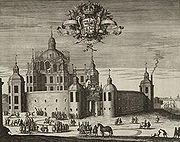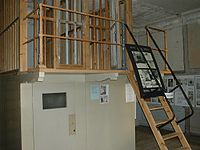
Svartsjö Palace
Encyclopedia

Färingsö
Färingsö or Svartsjölandet is an island in Sweden's Lake Mälaren. It covers an area of 79km². The island is a part of Ekerö Municipality. The largest village on the island is Stenhamra. The island is also named after the village of Svartsjö....
in lake Mälaren
Mälaren
Lake Mälaren is the third-largest lake in Sweden, after Lakes Vänern and Vättern. Its area is 1,140 km² and its greatest depth is 64 m. Mälaren spans 120 kilometers from east to west...
. It is a 30 minute car ride from Stockholm
Stockholm
Stockholm is the capital and the largest city of Sweden and constitutes the most populated urban area in Scandinavia. Stockholm is the most populous city in Sweden, with a population of 851,155 in the municipality , 1.37 million in the urban area , and around 2.1 million in the metropolitan area...
, the capital of Sweden
Sweden
Sweden , officially the Kingdom of Sweden , is a Nordic country on the Scandinavian Peninsula in Northern Europe. Sweden borders with Norway and Finland and is connected to Denmark by a bridge-tunnel across the Öresund....
.
History

Renaissance architecture
Renaissance architecture is the architecture of the period between the early 15th and early 17th centuries in different regions of Europe, demonstrating a conscious revival and development of certain elements of ancient Greek and Roman thought and material culture. Stylistically, Renaissance...
palace with a round inner courtyard. It was at least partly designed by Willem Boy
Willem Boy
Willem Boy was a Flemish painter, sculptor, and architect active in Sweden from around 1558 until his death.Few of Boy's works have survived, and he is mostly remembered for the sarcophagus of King Gustav I in the Uppsala Cathedral....
and completed in 1580 but burnt down in 1687. The remaining building material was shipped to Stockholm to be used in the build of the castle Tre kronor
Tre kronor (castle)
Tre Kronor or Three Crowns was a castle located in Stockholm, Sweden, on the site where Stockholm Palace is today. It is believed to have been a citadel that Birger Jarl built into a royal castle in the middle of the 13th century...
. The stone foundation was left and is visible today.
The current buildings middle section was started in 1734 and finished in 1739 on the order of Fredrik I
Frederick I of Sweden
Frederick I, , was a prince consort of Sweden from 1718 to 1720, and a King of Sweden from 1720 until his death and also Landgrave of Hesse-Kassel from 1730...
. It was built as a hunting palace for then current queen Ulrika Eleonora using drawings by Carl Hårleman
Carl Hårleman
Baron Carl Hårleman was a Swedish architect.Hårleman was born in Stockholm, son of the garden architect and head of the royal parks and gardens Johan Hårleman, who hade been ennobled in 1698, and began his architectural training under Göran Josua Adelcrantz...
. The now Rococo
Rococo
Rococo , also referred to as "Late Baroque", is an 18th-century style which developed as Baroque artists gave up their symmetry and became increasingly ornate, florid, and playful...
palace, raised by inspiration of French palaces, became a model for Swedish country mansion architecture during the later part of the 18th century.
The palace was extended on both short ends by drawings of Carl Fredrik Adelcrantz
Carl Fredrik Adelcrantz
Carl Fredrik Adelcrantz was a Swedish architect and civil servant. Adelcrantz's style developed from a rococo influenced by Carl Hårleman, the leading architect in Sweden in the early years of his career, to a classical idiom influenced by the stylistic developments in France in the mid-to-late...
, together with a bell tower. It was given to the Queen dowager Louisa Ulrika of Prussia
Louisa Ulrika of Prussia
Louisa Ulrika of Prussia was Queen of Sweden between 1751 and 1771 as the spouse of King Adolf Frederick of Sweden, and queen mother during the reign of King Gustav III of Sweden.-Background:...
in the 1770s.
The prison period

Modern restoration
After years of neglect the palace was restored from 1994 to 2003 by the state, to a cost of 36 million SEKSwedish krona
The krona has been the currency of Sweden since 1873. Both the ISO code "SEK" and currency sign "kr" are in common use; the former precedes or follows the value, the latter usually follows it, but especially in the past, it sometimes preceded the value...
. The façade has regained its light shade, made to resemble French sandstone. The windows are painted in a gold brown oak color. None of the original wallpaper was kept but wallpaper based on nearby Drottningholm Palace
Drottningholm Palace
The Drottningholm Palace is the private residence of the Swedish royal family. It is located in Drottningholm. It is built on the island Lovön , and is one of Sweden's Royal Palaces. It was originally built in the late 16th century. It served as a residence of the Swedish royal court for most of...
was used.
External links
(The external links below are in Swedish)- Swedish State Property Institute - description of Svartsjö Palace
- Interior decoration of four rooms in Svartsjö Palace
- Swartsiöö castleculture
- Tallius Myhrman architects – Images from the restoration of the palace
- Stockholms läns museum – Various images and paintings of the palace

